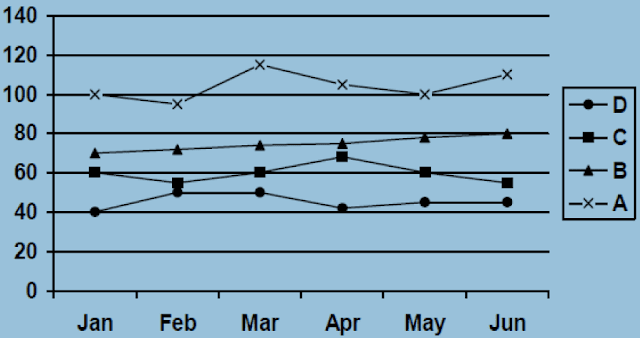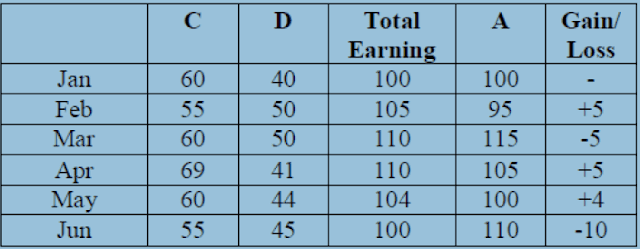Hello Friends, We are sharing some important Data Analysis and Interpretation & Caselets Questions with Answers solutions helpful for SBI and IBPS PO and Clerk exams 2017 2018. These data interpretation practice questions are very important for SBI PO exam and IBPS PO & other upcoming banking exams like for IBPS PO Pre and Mains, SBI PO Pre and Mains, SSC, CAT, XAT, NMAT, MAT & other exams 2017.
GRE Data Interpretation Questions and Caselets for bank exams provided by Bank4Study.com will help you a lot in your goal to crack the test. You will be taught to solve these questions better by solving many Data Interpretation and Caselets problems.
You need to practice as many DI Questions as possible for Competitive Exams. These questions will help you master the concepts of data interpretation better. Once you are sure that you have mastered the concepts involved in data interpretation, then you can easily crark the Quantitative Section of Exams.
GRE Data Interpretation Questions and Caselets for bank exams provided by Bank4Study.com will help you a lot in your goal to crack the test. You will be taught to solve these questions better by solving many Data Interpretation and Caselets problems.
You need to practice as many DI Questions as possible for Competitive Exams. These questions will help you master the concepts of data interpretation better. Once you are sure that you have mastered the concepts involved in data interpretation, then you can easily crark the Quantitative Section of Exams.
Data Interpretation Practice Questions
Directions for Question 1 to 5: The graph below shows the end of the month market values of 4 shares for the period from January to June. Answer the following questions based on this graph.
1: Which share showed the greatest percentage increase in market value in any month during the entire period?
(a) A
(b) B
(c) C
(d) D
2: In which month was the greatest absolute change in market value for any share recorded?
(a) March
(b) April
(c) May
(d) June
3: In which month was the greatest percentage increase in market value for any share recorded?
(a) February
(b) March
(c) April
(d) May
4: An individual wishes to sell 1 share of C and 1 share of D to buy 1 share of A at the end of a month. At which month end would the individual’s loss from this decision, due to share value changes, be the most?
(a) February
(b) March
(c) April
(d) June
5: An individual decides to sell 1 share of C and 1 share of D to buy 1 share of A at the end of the month. What can be the individual’s greatest gain from this decision, due to share value changes?
(a) 5
(b) 10
(c) 15
(d) none
Directions for Caselet 6 to 10: Answer the questions on the basis of the following information.
- Prakash has to decide whether or not to test a batch of 1000 widgets before sending them to the buyer. In case he decides to test, he has two options: (a) Use test I ; (b) Use test II.
- Test I cost Rs. 2 per widget. However, the test is not perfect. It sends 20% of the bad ones to the buyer as goo d.
- Test II costs Rs. 3 per widget. It brings out all the bad ones. A defective widget identified before sending can be corrected at a cost of Rs. 25 per widget. All defective widgets are identified at the buyer’s end and penalty of Rs. 50 per defective widget has to be paid by Prakash.
6: Prakash should not test if the number of bad widgets in the lot is:
(a) less than 100
(b) more than 200
(c) between 120 & 190
(d) Cannot be found out.
7: If there are 120 defective widgets in the lot, Prakash:
(a) should either use Test I or not test.
(b) should either use Test II or not test.
(c) should use Test I or Test II.
(d) should use Test I only.
8: If the number of defective widgets in the lot is between 200 and 400, Prakash:
(a) may use Test I or Test II
(b) should use Test I only.
(c) should use Test II only
(d) cannot decide.
9: If Prakash is told that the lot has 160 defective widgets, he should:
(a) use Test I only
(b) use Test II only.
(c) do no testing.
(d) either use Test I or do not test.
10: If there are 200 defective widgets in the lot, Prakash:
(a) may use either Test I or Test II
(b) should use Test I or not use any test
(c) should use Test II or not use any test.
(d) cannot decide.
What Others Are Reading
- Coding Decoding Questions Answers 25 Sets
- Puzzle 70 Sets for Exams - High Level
- How to Solve Input-Output Reasoning Questions Fast
- Blood Relations Questions - Shortcuts
- Seating And Circular Arrangement 95 Puzzles PDF 2017
- Series Completion Questions Tricks Shortcuts
- 10 Data Interpretation Sets - Free Download
Data Interpretation and Caslets Solutions
Answer 1: d
From the table we clearly seen that highest % increase is for D in Feb. i. e 25%
Answer 2: a
The greatest absolute change in the market value is 20 i.e. In
the month of March the share of A = 115 – 95 = 20
Answer 3: a
The greatest percentage change in any share was recorded for share D f or the month of February viz. 25%
Answer 4: d
Due to share value changes the maximum loss is 10 for the month of Jun e. Hence the answer is (d).
Answer 5: a
From the above table again w e can see that the individual’s highest gain is Rs.5.
Answer 6: a
Answer 6: a
Total number of batches = 1000
Let p be the total number of bad widgets
Therefore the total number of good ones will be (1000 –p).
On test I his total cost will be = Rs.2 (1000) + 25 x 0.8p + 50 x 0.2p
On test 2 his total cost will be = Rs. 3(1000) + 25 x p
Now, it will be worth testing if the cost of testing is less than the cost of penalty levied on the defective pieces. Let us check all the choices:
Above 100 defectives cost is cheaper than the penalty.
But for 100 defectives the cost of penalty is the same as that for testing.
Therefore we come to this conclusion that below 100 defectives, the penalty will be less than the cost of testing and hence it is not worth testing.
Answer 7: d
If there are 120 widgets, he should go for test I as it is cheaper.
Answer 8: c
From the table, we can say that if the number of defectives is between 200 & 400, he should go for Test II as it is cheaper.
Answer 9: a
In case of 160 defectives, he should use test I as it is cheaper.
Answer 10: a
As the cost of both the Tests is same = Rs.8000.
Prakash may use either Test I or Test II for 200 widgets



